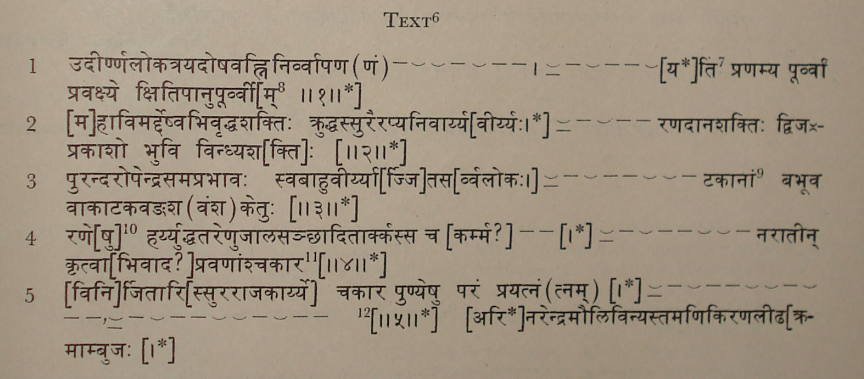|
INSCRIPTIONS OF THE MINISTERS AND FEUDATORIES OF THE
VATSAGULMA BRANCH
...As for the localities mentioned in this record, Kuntala generally denoted ‘the country
between the Bhīmā and the Vēdavatī, including the Sātārā and Shōlāpur Districts as well
as some Kanarese districts of the Bombay, Mysore and Madras States.’ According to some
writers, however, Kuntala stretched much farther to the north. Rājaśēkhara seems to identify
Kuntala with a part of Mahārāshṭra including Vidarbha1. Soḍḍhala, the author of the Udayasundrīkathā, states that Pratishthāna (modern Paiṭhaṇ in the former Haidarabad
State) on the Godāvarī was the capital of Kuntala2. Avanti is Western Malwa, the
capital of which was Ujjain (also called Avanti). Kaliṅga comprised the country along the
eastern coast between the Mahānadī and the Godāvarī. Kōsala is evidently Dakshiṇa Kōsala,
corresponding to modern Chhattisgaḍh and the adjoining parts of the Orissa State. The
exact location of Trikūta was long uncertain. From the description in Kālidāsa’s Raghuvaṁśa it was of course known that the mountain Trikūṭa after which the country was named was
situated in Aparānta (North Kōṅkaṇ)3. The dynasty of the Traikūtakas was also known
to have held parts of Kōṅkaṇ, Southern Gujarāt and Northern Mahārāshṭra. But which
part of the Western Ghāts was designated Trikūṭa was not known. The Añjanērī plates
mention Pūrva-Trikūṭa vishaya (Eastern Trikūṭa District ) in connection with certain taxes
levied in favour of a temple situated in the Nāsik District4. Trikūṭa seems therefore to
have comprised the country to the west of Nāsik. Lāṭa generally signifies Central and
Southern Gujarat, between the Mahī and the Tāpī, but in some records it is said to have
included the territory to the north of the Mahī as far as Kairā5. Finally, Andhara is the well
known name of the Telugu-speaking country to the south of the Godāvari.

__________________
1 Rājaśēkhara, Bālarāmāyaṇa, Act III, verses 50-52 ; Act X, verses 74-75.
2 Uḍayasundarikathā (Gaekwad’s Oriental Series), pp. 21 and 83.
3 Raghuvaṁśa, canto IV, v. 59.
4 Ep. Ind., Vol. XXV, p. 40. C.I.I., Vol. IV, p. 149.
5 Ibid., Vol. XII, p. 40.
6 From the facsimile published in the Ep. Ind., Vol. XXVI, between pages 142 and 143.
7 This word was not noticed by the previous editors. The inscription in Ajaṇṭā Cave XVII
(No. 27) refers to the Buddha as
8 Metre of this and the next two verses : Upajāti.
9 These three aksharas are fairly clear. The complete word may have been उद्धुतकंटकानाम्.
10 This was the reading of Bhagvanlal. Bühler read स्वहर्य्य-.
11 Metre : Upajāti.
12 Metre : Upēndravajrā or Upajati.
|